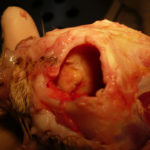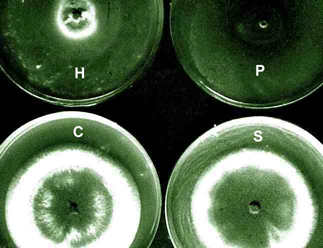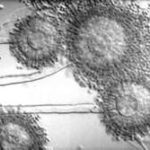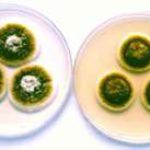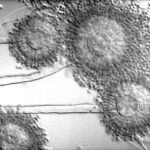Date: 26 November 2013
The growth isolated from the aspergilloma in the presence of living cells of the three bacterial species in culture.The most marked inhibition occurred with Pseudomonas aeruginosa(P) and Haemophilus influenzae(H) and to a much lesser extent with Staphylococcus aureus(S). C=control. Inhibitory factors were components of the bacterial slime layers.
Copyright:
Fungal Research Trust
Notes:
Colonies on CYA 40-60 mm diam, plane or lightly wrinkled, low, dense and velutinous or with a sparse, floccose overgrowth; mycelium inconspicuous, white; conidial heads borne in a continuous, densely packed layer, Greyish Turquoise to Dark Turquoise (24-25E-F5); clear exudate sometimes produced in small amounts; reverse pale or greenish. Colonies on MEA 40-60 mm diam, similar to those on CYA but less dense and with conidia in duller colours (24-25E-F3); reverse uncoloured or greyish. Colonies on G25N less than 10 mm diam, sometimes only germination, of white mycelium. No growth at 5°C. At 37°C, colonies covering the available area, i.e. a whole Petri dish in 2 days from a single point inoculum, of similar appearance to those on CYA at 25°C, but with conidial columns longer and conidia darker, greenish grey to pure grey.
Conidiophores borne from surface hyphae, stipes 200-400 µm long, sometimes sinuous, with colourless, thin, smooth walls, enlarging gradually into pyriform vesicles; vesicles 20-30 µm diam, fertile over half or more of the enlarged area, bearing phialides only, the lateral ones characteristically bent so that the tips are approximately parallel to the stipe axis; phialides crowded, 6-8 µm long; conidia spherical to subspheroidal, 2.5-3.0 µm diam, with finely roughened or spinose walls, forming radiate heads at first, then well defined columns of conidia.
Distinctive features
This distinctive species can be recognised in the unopened Petri dish by its broad, velutinous, bluish colonies bearing characteristic, well defined columns of conidia. Growth at 37°C is exceptionally rapid. Conidial heads are also diagnostic: pyriform vesicles bear crowded phialides which bend to be roughly parallel to the stipe axis. Care should be exercised in handling cultures of this species.
Images library
-
Title
Legend
-
Microbroth dilution of A.fumigatus against itraconazole. The rows at the top show complete inhibition (susceptible) and the centre row shows no inhibition at all (resistant). An MIC of 4 mg/l (2 clear wells to the right) is shown for the bottom row (susceptible).
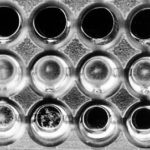
-
Itraconazole standards are placed in duplicate in a pre-arranged order and distributed throughout the plate. Patient samples of serum or plasma are placed in duplicate in other wells. A standard curve is drawn using the measured diameters of the standards and the patients’ samples then determined. The bioassay measures both itraconazole and the major bioactive metabolite of itraconazole – hydroxitraconazole.
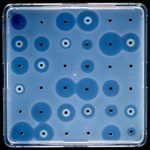
-
This image shows the next three concentrations of 8, 16 and 32 mg/l. AF72 is inhibited by 16 mg/l of amphotericin B, but not at any concentration of itraconazole.
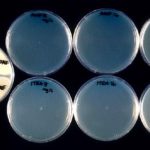
-
This image shows the next three concentrations of drugs – 1, 2 and 4 mg/l. Isolates AF6, AF10, AF19 and AF20 are inhibited at 2 mg/l and AF 11 at 4 mg/l amphotericin B

-
Six isolates of A.fumigatus, of which one (AF72) is documented to be itraconazole resistant. On the left is the control plate, showing good growth at 48 hr on Sabouraud dextrose agar. The next three pairs of plates contain increasing and equal concentrations of amphotericin B (top row) and itraconazole (bottom row). AF72 is a slowly growing isolate that is not inhibited by any concentration of either drug, AF11 is fully susceptible to itraconazole (
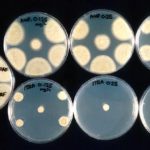
-
Nasal, sinus and orbital aspergillosis in a cat. The left nasal cavity and sinus were full of pus and debris and there was severe bone erosion from the nasal cavity into the rostromedial orbitthrough which pus was protruding
